General Principles Of Operative Surgery Long Essays
Question 1. What is sterilisation? What are the methods of sterilizing surgical materials? Mention the merits and demerits.
Answer:
Sterilisation:
- Sterilisation is defined as a process by which an article, object or surface is free of all micro-organisms in the vegetative form and in the spore state.
Sterilisation Physical Methods
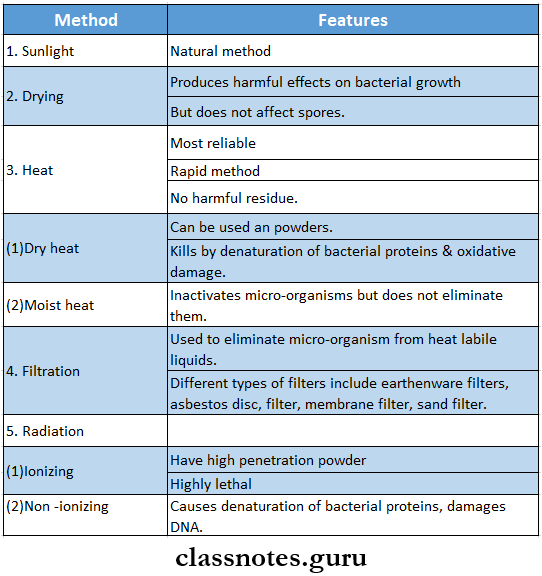
Sterilisation Chemical Agents
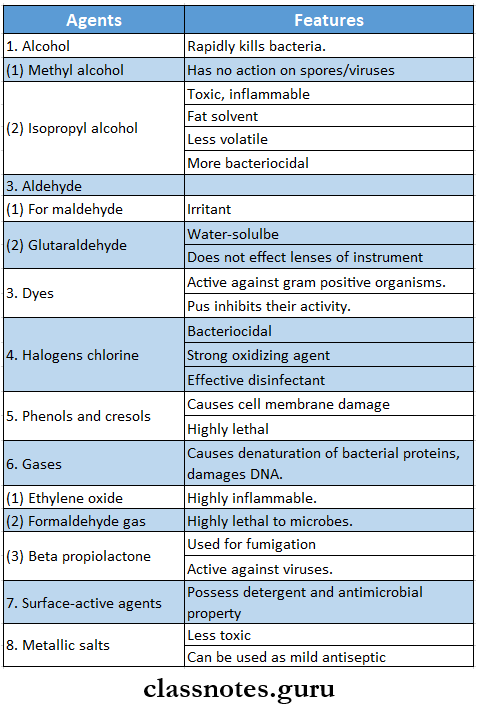
General principles of operative surgery Q&A
General Principles Of Operative Surgery Short Essays
Question 1. Autoclave.
Answer:
Autoclave
Autoclaving is the process of sterilization by saturated steam under high pressure above 100°C temperature.
Autoclave Principle:
- Water boils when its vapour pressure equals that of the surrounding atmosphere.
- When the atmospheric pressure is raised then the boiling temperature is also increased.
- At normal pressure water boils at 100oC but when pressure inside a closed vessel increases, the temperature at which water boils also increases.
- When steam comes into contact with a cooler surface, it condenses to water and gives up its Latent heat to the surface.
Read And Learn More: General Surgery Question and Answers
Sterilisation conditions:
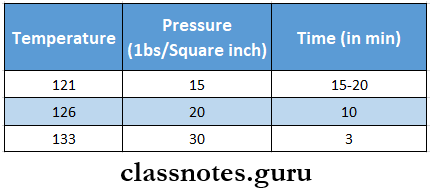
Sterilisation Control:
- Spores of bacillus stearothermophilus.
- Brown’s tubes.
- Thermocouples.
- Autoclave tapes.
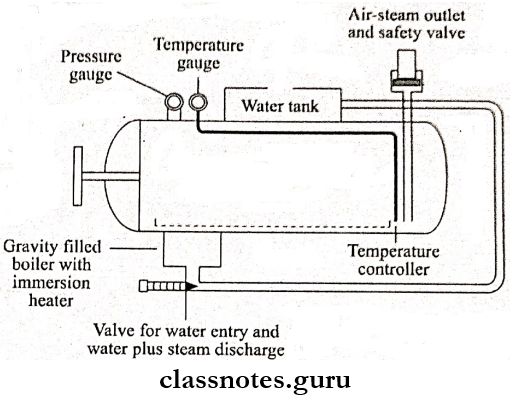
Autoclave Uses:
- Used for sterilisation of
- Culture media.
- Rubber articles.
- Syringes and surgical instruments
- OT gowns and dressing materials.
- Endodontic instruments.
Question 2.Absorbable suture material.
Answer:
Absorbable Suture Material
- Various processes like hydrolysis and proteolytic enzymatic degradation break down absorbable sutures.
- They are made from either natural or synthetic polymers.
Absorbable Suture Material Classification:

Operative surgery questions and answers
Question 3. Cryosurgery.
Answer:
Cryosurgery
Cryosurgery is the deliberate destruction of tissue by the application of extreme cold.
- Barnard introduced it.
- The temperature used for it is -20°C to -180°C.
Cryosurgery Methods Employed Are:
- Spray freeze technique.
- Applicator technique.
- Cryoprobe method.
- Thermocouple method.
Cryosurgery Technique:
- Anaesthetize the area.
- Freeze the exposed nerve for 2 min.
- Wait for 5 min.
- Next freeze it for another 3 min.
Cryosurgery Uses:
- Keratotic lesions.
- Granulomatous lesions.
- Hyperplastic lesions.
- Vascular and pigmented lesions.
- Salivary gland lesions.
- Gingival lesions.
- Periodontal diseases.
Cryosurgery Effects:
- Dehydration.
- Denaturation of lipid molecules.
- Necrosis of tissues, capillaries, small arterioles and venules.
- Allows the destruction of the tumoral or any other pathological tissues.
Question 4. Antiseptics
Answer:
Antiseptics
Antiseptics is chemical that is applied to living tissues such as mucous membranes to reduce the number of micro-organisms present, through inhibition of their activity
Antiseptics Requirements:
- A broad spectrum of activity
- Fast acting
- Not affected by physical factors
- Non-toxic
- Surface compactable
- Easy to use
- Odourless
- Economical
Antiseptics Agents:
- Alcohols: ethyl alcohol
- Iodophors povidone iodine
- Hepatitis virus not susceptible to it
- Formulated as 1% iodine solution
- Not stable at high temperature
- Hexachlorophene
- Toxic
- Used in patients who are sensitive to iodine
- Chlorhexidine 0.075%
Surgical principles MCQs with answers
Question 5. Sutures
Answer:
Sutures Ideal requirements
- Should have
- Adequate strength
- Good knot-holding property
- Least reactive
- Easy to handle
- Less memory
- Easily available
- Cost-effective
Sutures Classification
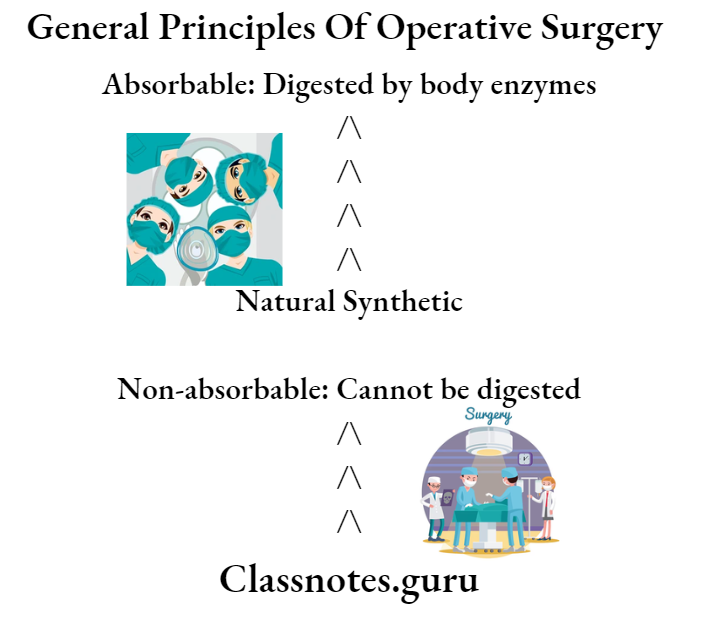
Coated Or Non-Coated: Coated with biologically inert non-resorbable compound
General Principles Of Operative Surgery Short Answers
Question 1. Antisepsis.
Answer:
Antisepsis
Antisepsis is defined as the prevention of infection by inhibiting the growth and multiplication of bacteria in wounds or tissues.
- Antiseptics are substances that kill or prevent the growth of microorganisms.
- English physician Sir John Pringle first used the word antiseptic.
- Commonly used antiseptics are:
- Alcohol.
- I-propanol.
- Isopropanol.
- Boric acid
- Brilliant green.
- Chlorhexidine gluconate.
- Hydrogen peroxide.
Question 2. Asepsis.
Answer:
Asepsis
- Asepsis means precautions taken before any surgical procedure, against the development of infection.
- Elimination of infection is the goal of asepsis.
Asepsis Examples:
- Washing the hands prior to delivery reduces puerperal fever.
- Wearing gloves before any procedure.
- Cleaning the operative site with iodine.
- Sterilisation of instruments.
Question 3. Disinfection.
Answer:
Disinfection
Disinfection means the destruction of all pathogens or organisms capable of producing infection but not necessary spores.
- Disinfection is less effective than sterilisation.
- Disinfection only reduces the number of microorganisms.
- Disinfection doesn’t need any strict protocol.
- Disinfection is commonly used in daily life.
- Thus, it prevents the spread of infection.
Short notes on operative surgery
Question 4. Sterilisation.
Answer:
Sterilisation Definition:
- Sterilisation is defined as a process by which an article, object or surface is free of all micro-organisms in the vegetative and spore form.
Sterilisation Classification:
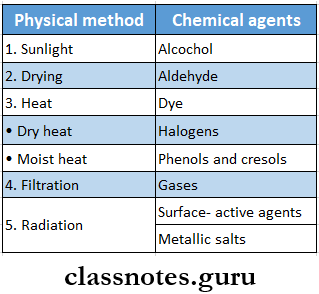
Sterilisation Uses:
- Sterilisation of materials or instruments used in surgical and diagnostic procedures.
- For media and reagents used in the microbiology laboratory.
Question 5. Sterilisation of hot air.
Answer:
Sterilisation Of Hot Air
- Sterilisation Of Hot Air is a method of sterilization using dry heat.
- Sterilisation Of Hot Air is the most widely used.
Temperature And Time:
- 160°C for 2 hours.
Sterilisation Of Hot Air Advantages:
- Safer to use – as it does not require water and high pressure.
- Suitable to work in the laboratory.
- Smaller in size.
- Rapid method.
Sterilisation Of Hot Air Disadvantages:
- Some organisms may not killed by it
Sterilisation Of Hot Air Uses:
- Used for sterilisation of
- Glasswares like glass syringes, flasks and test tubes.
- Surgical instruments like scalpels, and scissors.
- Chemicals such as liquid paraffin, and fats.
Question 6. Incineration.
Answer:
Incineration
Incineration is a waste treatment process that involves the combustion of organic substances contained in waste material.
- It converts waste into ash, fuel gas and heat.
- It is used to destroy soiled dressings, bedding, bandages, etc.
- Pathogens and toxins can be destroyed by high temperatures by it.
- An incinerator and a furnace is used for it.
Incineration Types:
- Moving grate
- Fixed grate
- Rotary kiln.
- Fluidized bed.
Question 7. Cidex,
Answer:
Cidex
- Cidex is one of the brand names of glutaraldehyde.
- It is effective against mycobacterium, fungi and viruses.
Cidex Advantages:
Doesn’t affect the lens of the instrument.
Cidex Disadvantages:
- Toxic, oils liquid.
- Harmful if inhaled or swallowed.
- Irritating to eyes and respiratory tract.
- Can cause severe damage to skin and eyes.
Cidex Uses:
- Used to sterilise cystoscopes, bronchoscopes, endotracheal tubes and metallic instruments,
Question 8. Diathermy.
Answer:
Diathermy
Diathermy is a therapeutic treatment most commonly prescribed for joint conditions.
In it, a high-frequency electric current is delivered via shortwave, microwave or ultrasound to generate deep heat in body tissues.
Diathermy Effects:
- Promotes blood flow.
- Improves flexibility in stiff joints.
- Decreases pain and inflammation.
- Causes blood to coagulate and vessels to be sealed off or centralised.
- Removes tumour cells.
Diathermy Types:
- Shortwave diathermy.
- Microwave diathermy.
- Ultrasound diathermy.
Diathermy Side-effects:
- Causes extreme heat in metal devices such as bone pins, dental fillings and metal sutures.
- Causes burn in adjacent tissues.
- Can cause shock or burn.
Diathermy Uses:
- Arthritis.
- Back pain.
- Arthralgia.
- Fibromyalgia.
- Muscle spasms.
- Neuralgia.
- Bone injuries.
- Bursitis.
- In treatment of tumour.
Viva questions on principles of surgery
Question 9. Cryosurgery
Answer:
Cryosurgery
- Cryosurgery is the deliberate destruction of tissue by the application of extreme cold
- It was introduced by Barnard
- Temperature used is -20 degree C to -180 degree C
- Technique
- Anaesthesize the area
- Freeze the exposed nerve for 2 min
- Wait for 5 min
- Next freeze for other 3 min
Cryosurgery Uses:
- Keratotic lesions
- Granulomatous lesions
- Hyperplastic lesions
- Vascular and pigmented lesions
- Salivary gland lesions
- Gingival lesions
- Periodontal lesions
Question 10. Types of biopsy
Answer:
Types Of Biopsy
Type of Biopsy is the removal of part of tissue for the purpose of histological examination and analysis
Biopsy Types:
1. Punch Biopsy: The sample is obtained with the help of a punch
Biopsy Indications:
- Mucosal lesions
- Inaccessible areas
2. Incisional Biopsy:
Indication: large lesions
Tumours Edge biopsy is taken where the tumour cells can be compared with the normal cells
3. Excisional Biopsy:
Indication: small lesions
The entire lesion is excised in a single sitting and sent for histological examination
4. Needle Biopsy: FNAC
Indication: cystic cavity: A 23-26 gauge needle is used to aspirate the contents of the lesion
Question 11. Drains
Answer:
Drains Need for Drainage:
- Obliterate dead space
- Removal of foreign bodies
- Evacuate fluid/ blood/ urine from body
Drains Indications:
- Abscess cavities
- Surgical defects
- Urinary retention
- Gastric lavage
- Osteomvelitic lesions
Drains Functions:
- Escape of fluids from body
- Introduce drugs into the body
Drains Types:
- Simple rubber catheter
- Corrugated rubber drain
- Infant feeding tube
- Foley’s catheter
- Nasogastric tube
Basic surgical techniques questions
Question 12. Name suture materials
Answer:
Suture Materials Classification:
Absorbable: Digested by body enzymes
/\
/\
/\
/\
Natural Synthetic
Non-absorbable: Cannot be digested
/\
/\
/\
Natural Synthetic
Coated Or Non-Coated: Coated with biologically inert non-resorbable compound
